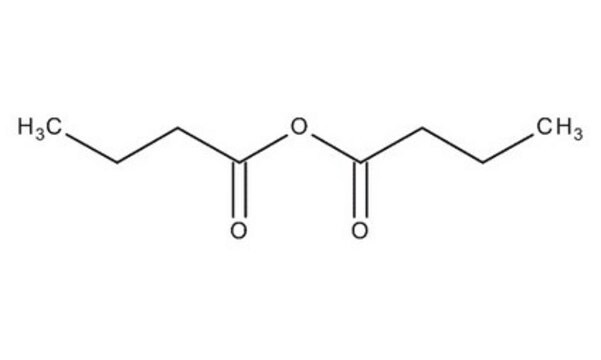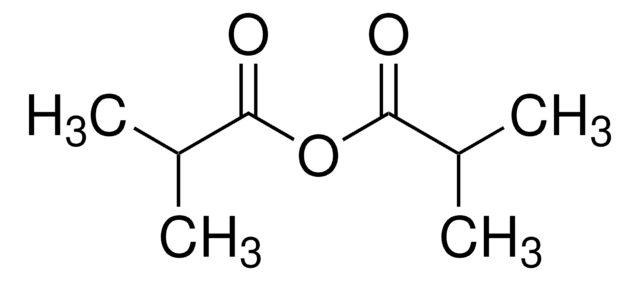19270
Butyric anhydride
purum, ≥97.0% (NT)
Synonyme(s) :
Butanoic anhydride
About This Item
Produits recommandés
Densité de vapeur
5.45 (vs air)
Niveau de qualité
Pression de vapeur
10 mmHg ( 79.5 °C)
Qualité
purum
Pureté
≥97.0% (NT)
Température d'inflammation spontanée
535 °F
Limite d'explosivité
1.1 %, 104 °F
7.6 %, 144 °F
Indice de réfraction
n20/D 1.413 (lit.)
n20/D 1.413
Point d'ébullition
198-199 °C (lit.)
Pf
−75-−66 °C (lit.)
Solubilité
alcohol: soluble (with decomposition)(lit.)
diethyl ether: soluble(lit.)
water: soluble (with decomposition)(lit.)
Densité
0.967 g/mL at 25 °C (lit.)
Chaîne SMILES
CCCC(=O)OC(=O)CCC
InChI
1S/C8H14O3/c1-3-5-7(9)11-8(10)6-4-2/h3-6H2,1-2H3
Clé InChI
YHASWHZGWUONAO-UHFFFAOYSA-N
Vous recherchez des produits similaires ? Visite Guide de comparaison des produits
Application
- dibutyrylchitin, a lipophilic chitin diester
- N-(2-acetamido-2-deoxy-β-D-glucopyranosyl)-n-butyramide
- butyric-ester derivatives of hyaluronic acid
Mention d'avertissement
Danger
Mentions de danger
Classification des risques
Acute Tox. 4 Oral - Eye Dam. 1 - Skin Corr. 1B
Risques supp
Code de la classe de stockage
8A - Combustible corrosive hazardous materials
Classe de danger pour l'eau (WGK)
WGK 1
Point d'éclair (°F)
188.6 °F - closed cup
Point d'éclair (°C)
87 °C - closed cup
Équipement de protection individuelle
Faceshields, Gloves, Goggles, type ABEK (EN14387) respirator filter
Choose from one of the most recent versions:
Déjà en possession de ce produit ?
Retrouvez la documentation relative aux produits que vous avez récemment achetés dans la Bibliothèque de documents.
Les clients ont également consulté
Notre équipe de scientifiques dispose d'une expérience dans tous les secteurs de la recherche, notamment en sciences de la vie, science des matériaux, synthèse chimique, chromatographie, analyse et dans de nombreux autres domaines..
Contacter notre Service technique











